Switzerland is a paradise for adventure lovers, offering breathtaking mountains and diverse terrain. Whether you are a beginner or an experienced climber, there are rock climbing spots in Switzerland that cater to every skill level. From scenic alpine routes to challenging cliffs, these destinations combine thrill with stunning views. In this guide, we’ll explore the most epic climbing spots you won’t want to miss.
Top Rock Climbing Spots in Switzerland
1. Saxon Alps – Beginner-Friendly Routes
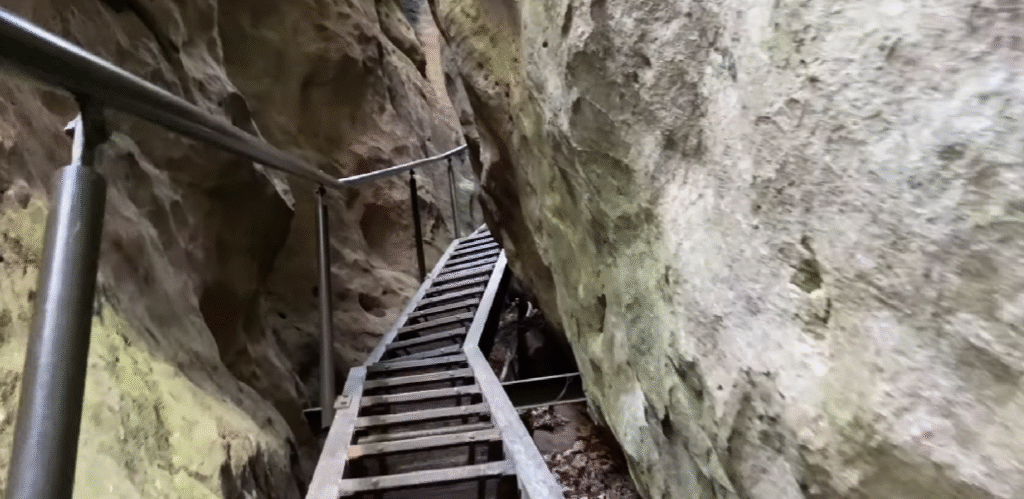
The Saxon Alps are some of the most accessible rock climbing spots in Switzerland, perfect for beginners who want to climb safely while enjoying incredible alpine views.
- Papststein – Route “Himmelsleiter” (Grade III)
Height: ~60 m. Mostly vertical with large footholds and ledges. Great for practicing top-rope and belaying techniques.
Access: 15-minute walk from Papststein parking area.
Tip: Start early to avoid queues; the summit offers breathtaking views over the Elbe Sandstone Mountains. - Schrammsteine – Route “Kleiner Zschand” (Grade II)
Height: ~40 m. Wide holds, minimal exposure, and a beautiful viewpoint at the top.
Access: 30-minute hike from Schmilka village.
Tip: Wear shoes with good grip—sandstone can be slippery in the morning dew. - Kleine Bastei – Route “Basteischlucht” (Grade II–III)
Height: ~50 m. Gentle incline and well-bolted anchors make it ideal for first lead climbing practice.
Access: Take public transport to Bad Schandau, then a 20-minute walk.
Tip: After climbing, visit the famous Bastei Bridge for one of the best photo spots in the region. - Falkenstein – Route “Königsweg” (Grade III)
Height: ~70 m. Excellent for first multi-pitch climbs thanks to well-placed belay stations.
Access: 25-minute hike from Schmilka trailhead.
Tip: Best climbed in the morning for comfortable temperatures and good light for photos. - Affensteine – Route “Affenkopf” (Grade II)
Height: ~40 m. Gentle slope, large ledges, and easy navigation make it ideal for confidence building.
Access: 20-minute walk from Bad Schandau.
Tip: Pack a small picnic—there are flat, scenic spots at the summit perfect for a break.
2. Zermatt – Alpine Climbing Adventures
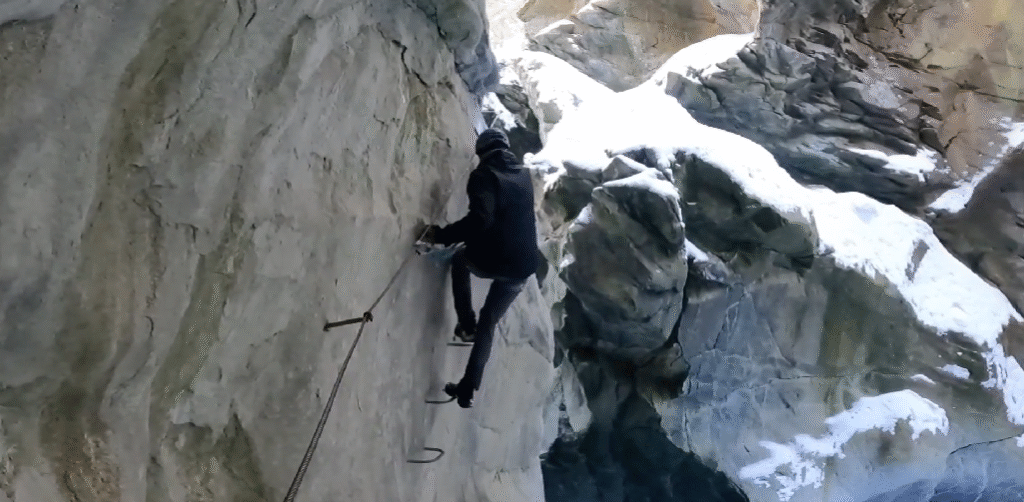
Zermatt is a dream for climbers, combining high-altitude granite walls, glacier views, and easy access from a charming alpine village. These routes capture the best of the region and showcase why Zermatt is one of the premier rock climbing spots in Switzerland.
- Riffelhorn – South Face (Grade III–IV)
Height: ~300 m. A sunlit granite wall with multiple pitches, perfect for getting used to altitude before tackling bigger alpine objectives.
Access: Take the Gornergrat Railway to Rotenboden, then follow the marked trail.
Tip: Start early to catch the Matterhorn glowing in morning light. - Biner Slab – Route “Seilbahn” (Grade II–III)
Height: ~120 m. Smooth granite slab with great friction, making it ideal for balance practice and relaxed climbing days.
Access: 15 minutes from the Furi cable car station.
Tip: Great for photography—clear views of the surrounding peaks. - Riffelhorn – West Ridge (Grade IV)
Height: ~250 m. A varied climb with cracks, ledges, and stunning alpine views—an unforgettable part of any Switzerland climbing experiences itinerary.
Access: Same as South Face; trail wraps around to the west.
Tip: Good step up for those moving from sport climbing to trad. - Gorner Gorge – Route “Klettersteig” (Via Ferrata)
Height: ~200 m vertical gain. Steel cables and ladders make this exciting yet safe, winding through one of Zermatt’s most dramatic natural features.
Access: 15-minute walk from Zermatt center.
Tip: Gloves recommended for cable sections. - Trift – Granite Slabs (Grade III)
Height: ~150 m. Solid granite with wide, open vistas—classic outdoor climbing Switzerland in a serene setting.
Access: 45-minute uphill hike from Zermatt.
Tip: Best climbed from late spring to early autumn for stable weather.
3. Interlaken – Thrilling Multi-Pitch Climbs
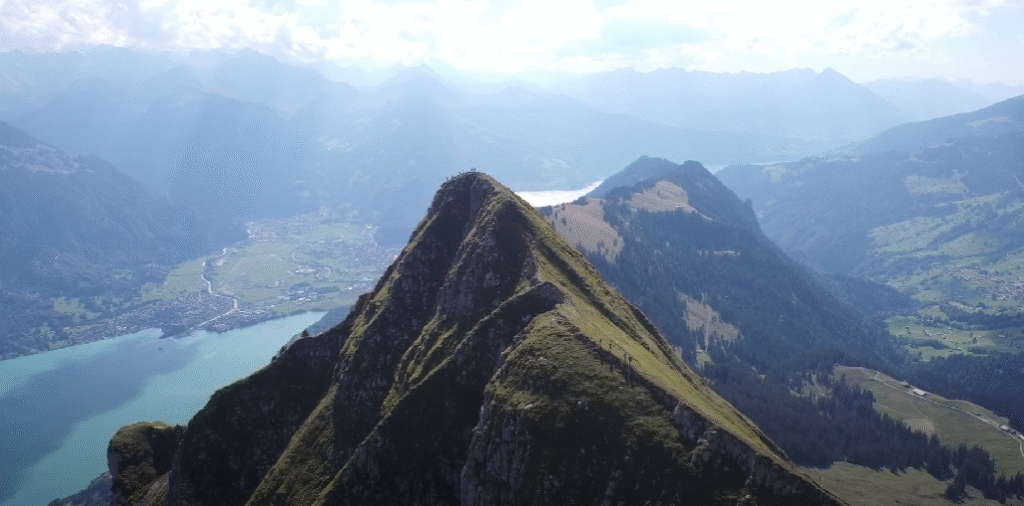
Interlaken, set between Lake Thun and Lake Brienz, is a prime base for climbers, offering dramatic walls, views of the Bernese Alps, and quick access to varied routes. The region is well represented among the most spectacular rock climbing spots in Switzerland.
- Hintisberg – South Wall (Grade V)
Height: ~350 m. An exposed wall with long lines, ideal for advanced climbers seeking technical challenges.
Access: 25-minute drive from Interlaken to Beatenberg, followed by a 1-hour hike up a marked trail.
Tip: Best climbed from June to September for stable weather conditions. - Lehn – “Südgrat” Route (Grade IV+)
Height: ~220 m. A classic route with solid rock and reliable protection, perfect for a full day out.
Access: 10-minute drive from Interlaken to Lehn parking, then a 20-minute walk.
Tip: A quieter location, great for avoiding crowds. - Schmocken – North Face Slabs (Grade III–IV)
Height: ~180 m. Smooth limestone slabs with delicate holds and sweeping valley views—one of the most scenic Switzerland climbing areas.
Access: Near Beatenberg village, with a marked trail leading directly to the base.
Tip: Ideal for practicing precise footwork and movement on small holds. - Rugen – “Panorama” Multi-Pitch (Grade V)
Height: ~300 m. A mix of crack and slab climbing, finishing with a spectacular ridge traverse.
Access: 5-minute drive from Interlaken, followed by a short 15-minute hike.
Tip: Bring gear for rappelling, as the descent is not a walk-off. - Roteflue – “Hoch über dem See” (Grade IV+)
Height: ~260 m. An airy climb with wide-open views of Lake Thun—clearly one of the top rock climbing locations in Switzerland.
Access: Approach via the village of Sundlauenen, then a steep 40-minute uphill trail.
Tip: Finish your day with a refreshing swim in the lake below.
4. Lauterbrunnen Valley – Scenic and Challenging Routes
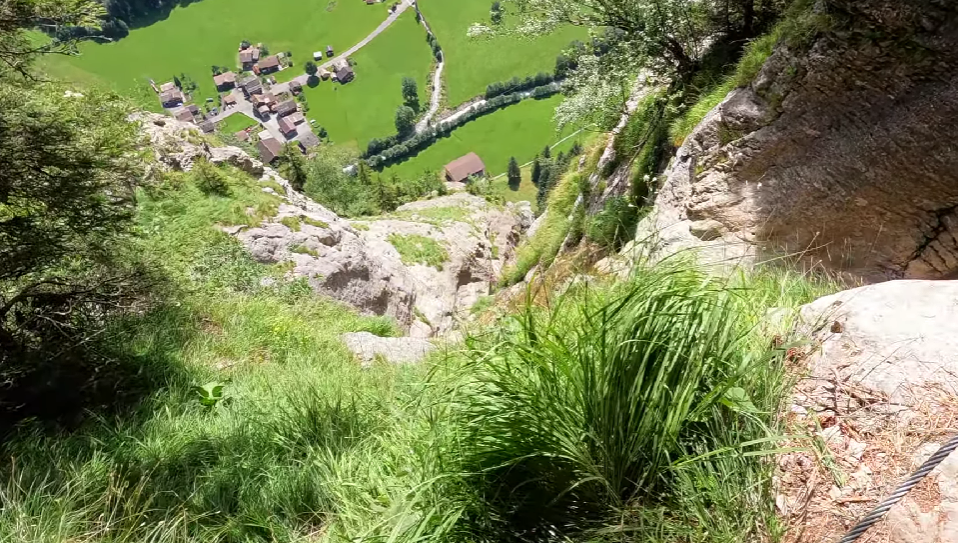
Famous for its towering cliffs, roaring waterfalls, and alpine meadows, Lauterbrunnen Valley is a dream location for climbers. It ranks high among the most beautiful rock climbing spots in Switzerland, offering everything from easy single-pitch walls to technical multi-pitch challenges.
- Staubbachwand – “Wasserfallkante” (Grade V+)
Height: ~300 m. A stunning line running right beside Staubbach Falls, blending exposure with incredible scenery.
Access: 10-minute walk from Lauterbrunnen train station.
Tip: Start early to avoid spray from the waterfall during midday winds. - Schwarzmönch – South Ridge (Grade IV–V)
Height: ~450 m. A historic alpine route, perfect for those seeking true Switzerland rock climbing destinations with a mix of scrambling and steep faces.
Access: Cable car to Mürren, then a 2-hour hike to the base.
Tip: Bring layers—wind chill can be strong at higher altitudes. - Hintisberg North Face (Grade VI)
Height: ~280 m. Steep limestone with sustained moves, ideal for seasoned climbers.
Access: Short drive to Isenfluh, followed by a steep 1-hour approach.
Tip: This wall stays shaded—pack warm gear even in summer. - Gimmelwald Crag (Grade III–IV)
Height: ~40 m single-pitch routes. Perfect for beginners and one of the best rock climbing spots in Switzerland for practicing lead climbing.
Access: Cable car to Gimmelwald; the crag is 5 minutes from the station.
Tip: Combine climbing with a picnic overlooking the valley. - Breithorn Slabs (Grade IV–V)
Height: ~200 m. Sweeping granite slabs with views of multiple waterfalls, a prime example of Switzerland climbing routes that balance beauty and challenge.
Access: Reachable from Stechelberg by hiking up 90 minutes along marked trails.
Tip: Best in late summer when snowmelt has receded.
5. Engelberg – Family-Friendly Climbing & Via Ferrata
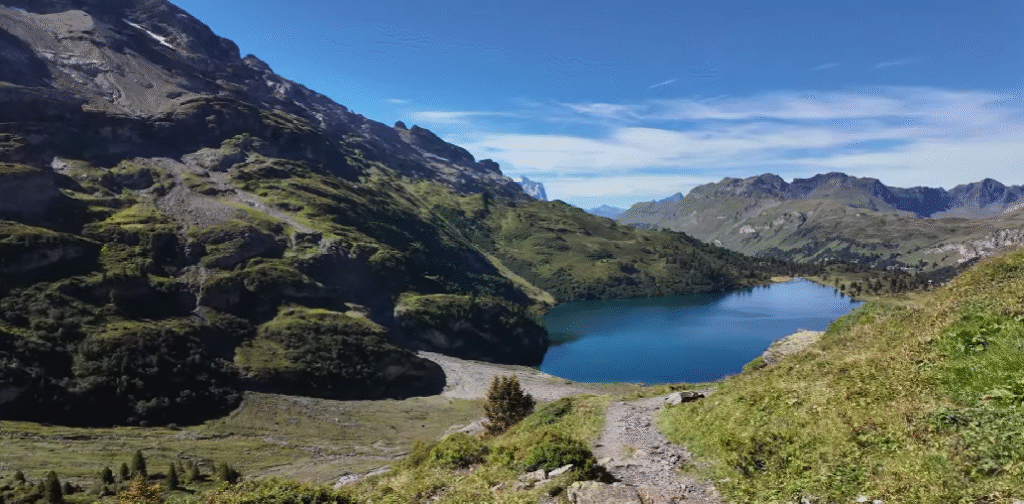
Engelberg, nestled in central Switzerland, is a fantastic destination for both thrill-seekers and families. Known for its welcoming atmosphere and accessible crags, it’s among the most versatile rock climbing spots in Switzerland.
- Brunni Climbing Garden (Grades III–V)
Height: ~15–30 m single-pitch. A safe and well-bolted area, ideal for beginner rock climbing Switzerland with children or new climbers.
Access: Cable car to Ristis, then a 10-minute walk.
Tip: Mornings are quieter—afternoons get busier with hiking groups. - Rigidalstock Via Ferrata
Height: ~320 m vertical gain. A mix of hiking, scrambling, and steel cable protection—perfect for those exploring popular rock climbing spots in Switzerland with minimal technical gear.
Access: Lift to Brunni, then a scenic 1.5-hour hike.
Tip: Gloves are essential for the steel cables; bring a camera for 360° alpine views. - Fürenwand Multi-Pitch (Grade VI)
Height: ~800 m. One of the tallest limestone walls in the region—challenging and exposed, suited for advanced climbers.
Access: Short drive from Engelberg village, then a 20-minute hike.
Tip: The wall gets morning sun but is shaded in the afternoon—plan your climb accordingly. - Gerschnialp Practice Slabs (Grades II–IV)
Height: ~10–20 m. A gentle slope-like crag, making it one of the must-visit rock climbing spots Switzerland for technique drills and warm-ups.
Access: Funicular from Engelberg to Gerschnialp, then 5 minutes on foot.
Tip: Excellent spot to combine with a picnic in the nearby meadows. - Hahnen Cliffs (Grades IV–V)
Height: ~100 m. Accessible alpine limestone with rewarding summit views of the Engelberg valley.
Access: Chairlift to Trübsee, then 1 hour on marked trails.
Tip: Great option for a half-day climb before catching the last lift back down.
Tips for Rock Climbing in Switzerland
- Check seasonal conditions – Many alpine crags are snow-covered until late spring; research your chosen area before planning rock climbing trips Switzerland.
- Start early in the day – Weather in the Alps can change rapidly, with storms often forming after noon.
- Bring layers – Even in summer, temperatures can drop dramatically at higher altitudes.
- Know your grade – Some routes are deceptively difficult; choose climbs that match your ability, especially at advanced rock climbing spots Switzerland.
- Use public transport when possible – Trains and cable cars often get you closer to the crags without the hassle of mountain parking.
- Respect local rules – Some areas have seasonal wildlife closures or restricted access to protect nesting birds.
- Carry cash – Small mountain huts and cable cars sometimes don’t accept cards.
- Hydrate and fuel – Many climbing spots are far from shops; bring enough water and snacks.
- Have a backup plan – Weather, route crowding, or maintenance can disrupt your climb; keep an alternative location in mind.
- Climb with a partner – While some crags allow for safe soloing, most Swiss climbing routes require a belay partner for safety.
Conclusion
- Discover breathtaking rock climbing spots in Switzerland.
- Experience routes for beginners and advanced climbers.
- Enjoy stunning alpine scenery while climbing.
- Find diverse challenges across Swiss regions.
- Make every climbing trip an unforgettable adventure.